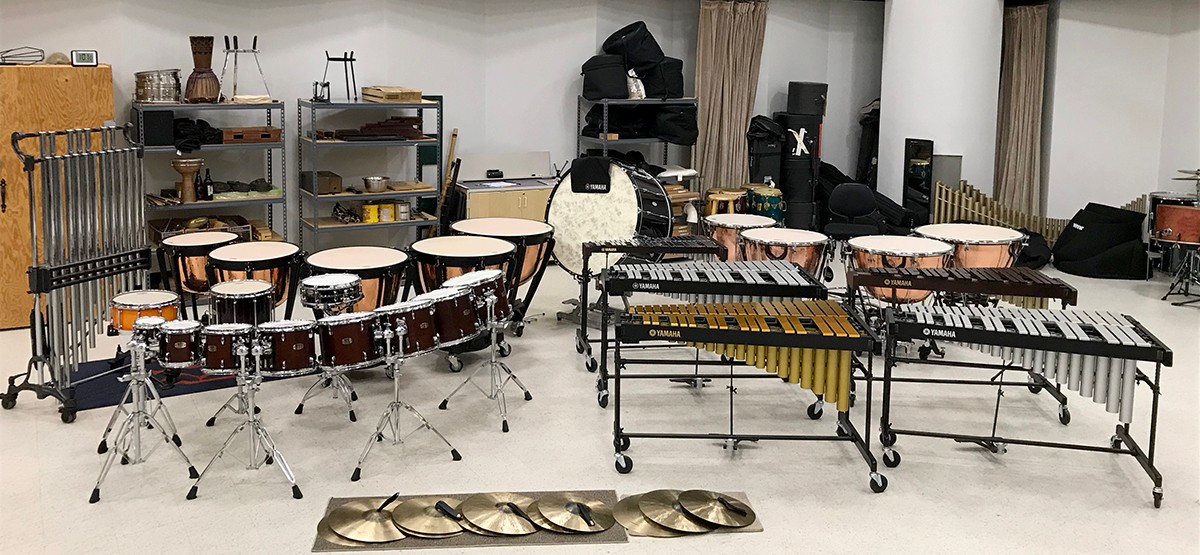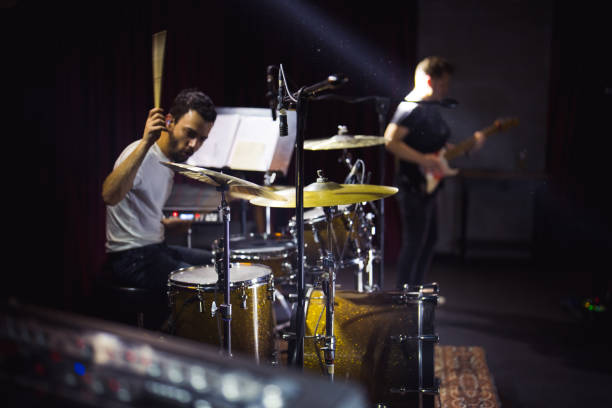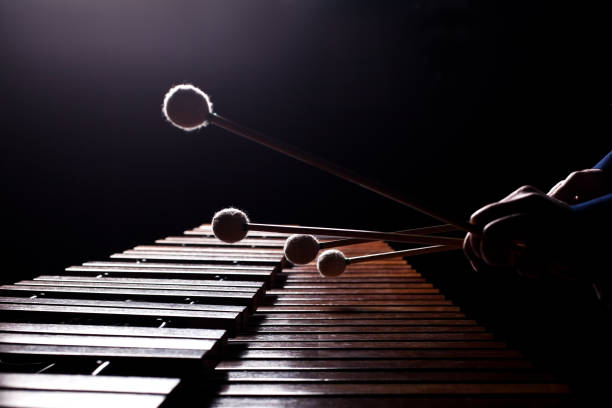The percussion instrument family has long been the heartbeat of music, providing rhythm, texture, and depth to compositions across the globe. Whether you’re a music enthusiast, a budding musician, or a seasoned percussionist, understanding these musical instruments can enrich your appreciation of music and broaden your musical horizons.
Introduction to Percussion Instruments
Definition and Broad Categorization
At its core, a percussion instrument is any musical instrument that produces sound through being struck, shaken, or scraped. The word “percussion” itself stems from the Latin term “percussio,” which means “to strike”. These instruments are among the oldest in human history, used in various forms across different cultures. Broadly, the percussion family can be categorized into two main types:
- Pitched Percussion Instruments: These instruments produce notes of definite pitch. Examples include the xylophone, marimba, and timpani. They are integral to both orchestral and solo performances. They can carry the melody or harmony within a musical piece.
- Unpitched Percussion Instruments: These instruments produce sounds of indefinite pitch. Examples include drums, cymbals, and tambourine. Their primary function is to maintain rhythm and add various textures to the music.
Understanding these basic categories helps in delving deeper into the world of percussion instruments and their unique contributions to music.
Types of Percussion Instruments
Detailed Look at Common Percussion Instruments
Drums
Drums are known for their versatility and widespread use in different music genres. They come in various forms, each contributing a unique sound and texture to musical compositions.
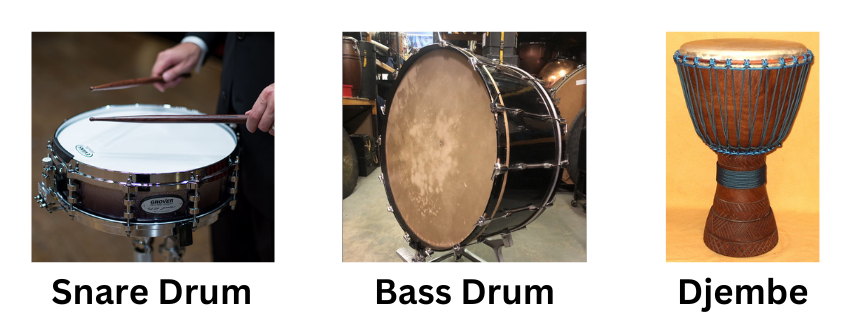
- Snare Drum: Known for its sharp, staccato sound, the snare drum is a staple in marching bands and orchestras. It consists of a shell, usually made of wood or metal, with two heads on both top and bottom. Metal wires (snares) are stretched across the bottom drumhead, creating a distinctive “snap” when struck. The snare drum is essential in providing a crisp and clear rhythm in both military and concert settings.
- Bass Drum: Producing a deep, resonant sound, the bass drum sets the foundation in many musical ensembles. It is the largest drum in a drum set and is played with a foot pedal. In orchestras and marching bands, the bass drums add the primary pulse, making it indispensable for maintaining tempo and adding dramatic effects.
- Djembe: Originating from West Africa, the djembe is known for its wide range of tones and is played with bare hands. A goblet-shaped drum, the djembe is crafted from a single piece of African hardwood and covered with an animal skin drumhead. It is highly versatile, capable of producing a wide spectrum of sounds and dynamics that are crucial in traditional African music and contemporary world music genres.
Many More Drums Beyond the Basics
This guide only scratches the surface by highlighting a few examples, but there are countless other drums, each with its unique sound, cultural significance, and playing technique. Here are a few more notable drums that contribute to the rich tapestry of global percussion:
- Congas: Tall, narrow drums from Cuba that are integral to Latin music, particularly salsa. Played with the hands, congas produce a rich, resonant sound and are often used in sets of two or more.
- Bongos: Smaller than congas, bongos consist of a pair of attached drums, each producing a different pitch. They are also central to Latin music and known for their sharp, high-pitched tones.
- Tabla: A pair of drums from India that are essential in Hindustani classical music. The tabla requires a highly specialized technique and emits a wide range of complex rhythms and tones.
- Cajón: A box-shaped percussion instrument from Peru, played by striking the front face with the hands. The cajón is popular in flamenco, Afro-Peruvian music, and various contemporary genres.
- Talking Drum: An hourglass-shaped drum from West Africa, known for its ability to mimic human speech. It is played with a curved stick and can be tuned by squeezing the drum’s cords, which alters the pitch.
- Bodhrán: A traditional Irish frame drum played with a wooden stick known as a tipper. The bodhrán is a staple in Celtic music and provides a rhythmic backbone for many traditional Irish tunes.
- Timpani: Also known as kettledrums, these large drums are a fixture in orchestras. Timpani are tunable and capable of producing specific pitches, making them essential for adding depth and resonance to symphonic music.
Mallet Instruments
Mallet instruments, also known as keyboard percussion, include a range of tuned percussion instruments that are struck with mallets. Such instruments are essential in both the orchestra and solo contexts due to their ability to produce precise pitches and their versatile tonal qualities. Here, we explore four prominent members of this family: the xylophone, marimba, vibraphone, and glockenspiel.
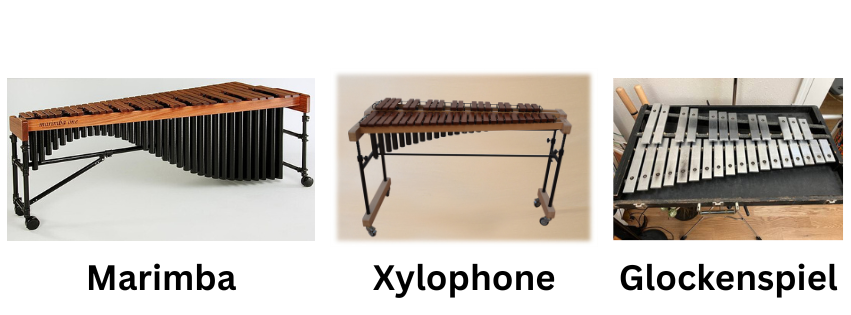
Xylophone
The xylophone consists of wooden bars of varying lengths, which are struck with mallets to produce musical notes. Each bar is tuned to a specific pitch, making it a pitched percussion instrument. The xylophone is notable for its bright, resonant sound and its role in both classical and contemporary music.
- The modern orchestral xylophone typically spans over three to four octaves, offering a rich range of notes. It is often used to play fast, intricate passages due to its clear and penetrating tone. Composers like Igor Stravinsky and Leonard Bernstein have utilized the xylophone to add distinctive musical colours and rhythmic patterns to their works.
Marimba
The marimba is similar to the xylophone but features a deeper and warmer sound due to its construction. The bars on a marimba are wider and thicker, and they are usually made from rosewood or synthetic materials. Resonators are placed under each bar to amplify the sound and add richness to the tones.
- Marimbas often span over four to five octaves, making them suitable for both melodic and harmonic roles in compositions. They are a staple in contemporary classical music, jazz, and even some popular music genres.
- The marimba’s mellow sound is often compared to that of a wooden piano, and it is known for its expressive capabilities. Composers like Paul Creston and Ney Rosauro have written extensively for the marimba, showcasing its vast dynamic range and emotive potential.
Glockenspiel
The glockenspiel, sometimes referred to as orchestral bells, consists of metal bars that produce a bright and bell-like sound when struck with mallets. The bars are arranged in a keyboard layout, making it easy for percussionists to play.
- This instrument has a smaller range, typically spanning 2.5 to 3 octaves, and produces very high-pitched tones. It is often used in orchestras to add a sparkly, ethereal quality to the music.
- The glockenspiel’s clear, piercing tones make it ideal for adding highlights and accents within orchestral and band settings. Composers like Pyotr Ilyich Tchaikovsky and Gustav Mahler have effectively employed the glockenspiel to emphasize crucial moments in their compositions.
Understanding the nuanced differences and unique characteristics of these mallet instruments can greatly enhance one’s appreciation of their role in various musical contexts. Each instrument offers its distinct timbre and expressive possibilities, contributing to the richness and diversity of percussion sections in music.
Vibraphone
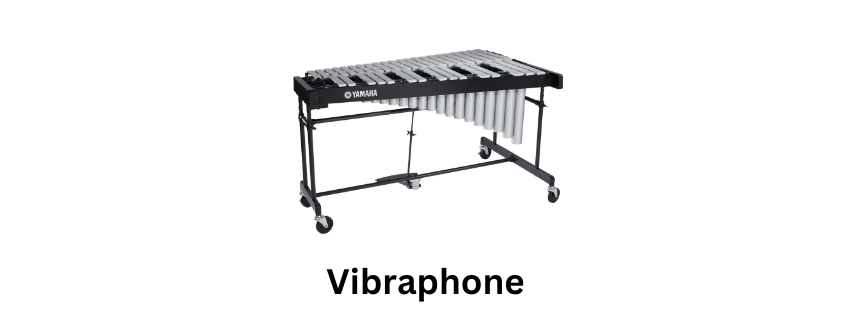
The vibraphone, distinguished by its metallic bars and motor-driven resonators, produces a unique, shimmering sound. The instrument features a sustain pedal, much like a piano, allowing for control over the length of each note.
- Vibraphones typically cover a range of three to four octaves and are a pivotal component in jazz music. The motor-driven resonators, also known as fans, create a vibrato effect that adds depth and texture to the sound.
- Notable vibraphonists like Lionel Hampton and Gary Burton have pushed the boundaries of the instrument, exploring its capabilities in both solo and ensemble performances.
Cymbals
Cymbals are percussion instruments made from thin round metal plates. They are typically crafted from alloys of copper, tin, and sometimes silver, giving cymbals their distinctive sound and durability. The proportion of these metals can vary, affecting the cymbal’s tone, resonance, and overall quality. The most common alloy used is a bronze mixture known as B20, comprising 80% copper and 20% tin. There are also B8 cymbals, which are made with 92% copper and 8% tin, known for their bright and cutting sound.
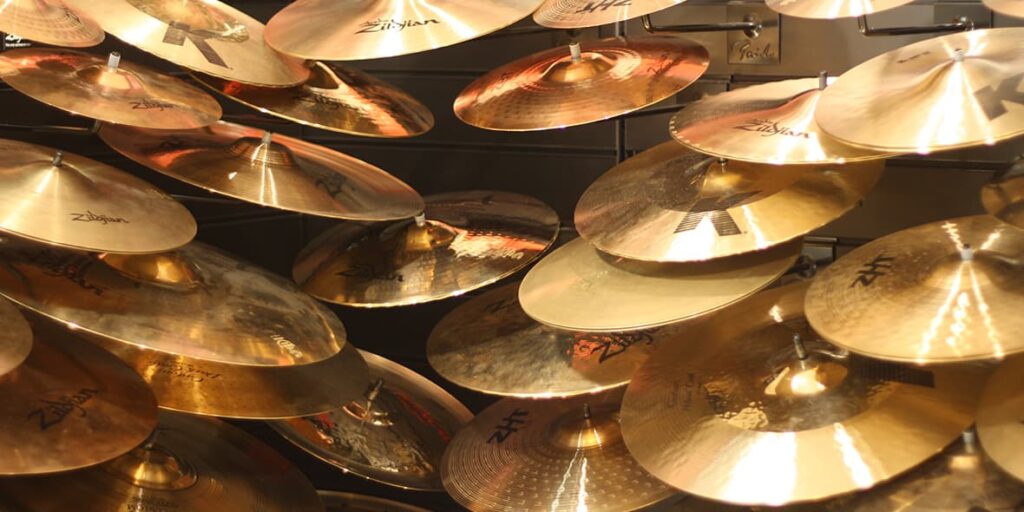
Orchestral Cymbals
- Handheld Crash Cymbals: These are typically played in pairs and are struck together to produce a powerful, sharp sound. Used extensively in orchestral and marching band settings, handheld crash cymbals add dramatic accents and emphasize key musical moments. They are usually held by straps and require precise timing and technique to create the desired effects.
- Suspended Cymbal: A single cymbal mounted on a stand, the suspended cymbal is struck with mallets, sticks, or brushes to produce a variety of sounds, from subtle crescendos to dramatic crashes. It is versatile and can be used to create long, sustained tones or quick, accentuated hits, offering an array of dynamic possibilities in orchestral and ensemble music.
Drum Set Cymbals
- Ride Cymbal: Integral to a drum set, the ride cymbal provides a steady, rhythmic pattern known as the “ride pattern.” It is usually larger and thicker than other cymbals, resulting in a clear, sustained “ping” sound when struck with a drumstick. The ride cymbal is essential for maintaining the tempo and adding texture to various music genres, especially in jazz and rock.
- Crash Cymbal on Drum Set: Known for its loud, explosive sound, the crash cymbal is used to accentuate transitions and highlight moments within a musical piece. It is typically medium-sized and often paired with the ride cymbal in a drum set. Crash cymbals are crucial for adding energy and excitement, especially in rock, pop, and jazz music.
- Hi-Hat Cymbals: Consisting of two cymbals mounted on a stand, the hi-hat cymbals can be played by opening and closing them with a foot pedal or striking them with drumsticks. They produce a variety of sounds, from a crisp “chick” when closed to a sloshy, sustained sound when partially open. Hi-hat cymbals are central to modern drum kits, providing rhythmic precision and versatile sound options in many musical styles.
Importance of Percussion in Music
Its Role in Different Music Genres and Cultural Contexts
Percussion instruments play a vital role in various music genres, often driving the rhythm and enhancing the overall texture of the music.
- Classical Music: In orchestras, percussion instruments like timpani, snare drums, and cymbals provide dramatic effects and rhythmic support. They add dynamic contrasts and help convey the emotional spectrum of classical compositions. The use of percussion in classical music has evolved over centuries, from simple rhythmic accents to complex, integral parts of the orchestration.
- Jazz: The drum kit is central to jazz, with the drummer maintaining the rhythm and adding complex syncopations and improvisations. Jazz percussionists like Max Roach and Art Blakey have demonstrated the importance of drumming in jazz, showing how it can lead a band and interact dynamically with other musicians. The use of brushes, sticks, and mallets on various drum surfaces and cymbals contributes to jazz’s distinct swing and bebop styles.
- Rock and Pop: Percussion provides the backbone of rock and pop music, with the drum kit being crucial for maintaining steady beats and driving energy. Drummers like Ringo Starr and Keith Moon have become legends not just for their technical skills but for their ability to energize and elevate a song’s overall impact. Percussion instruments like tambourines, bongos, and electronic drums also find their place in these genres, adding diverse textures and layers to the music.
Conclusion
Percussion instruments are the heartbeat of music, providing rhythm, depth, and emotion to compositions across all genres and cultures. From the ancient rituals of early civilizations to the contemporary hits topping today’s charts, percussion instruments continue to play a crucial role in the world of music.

